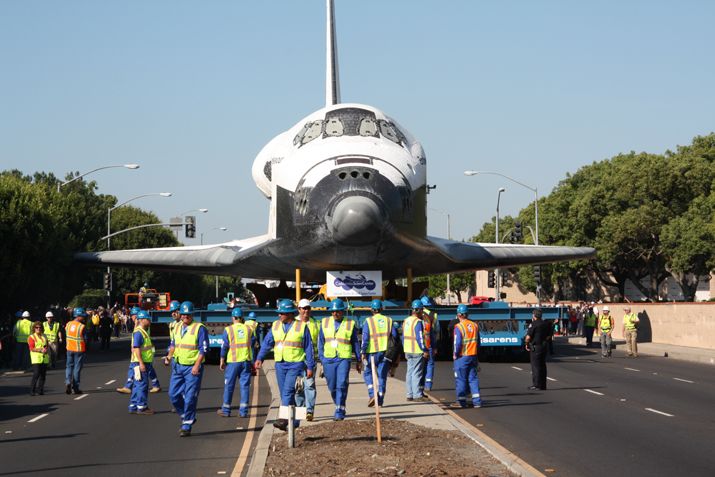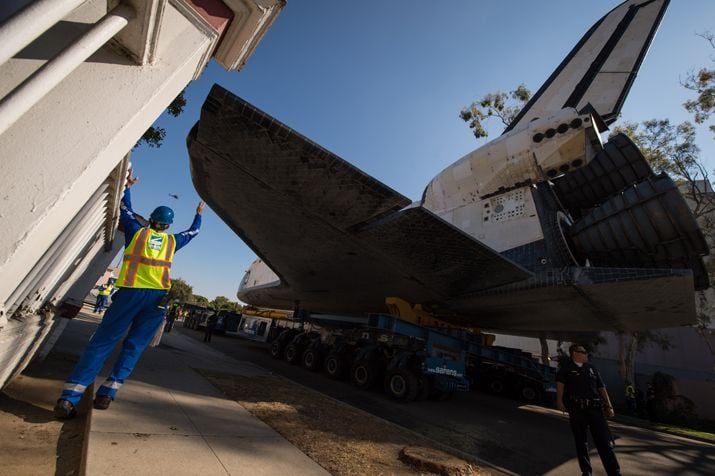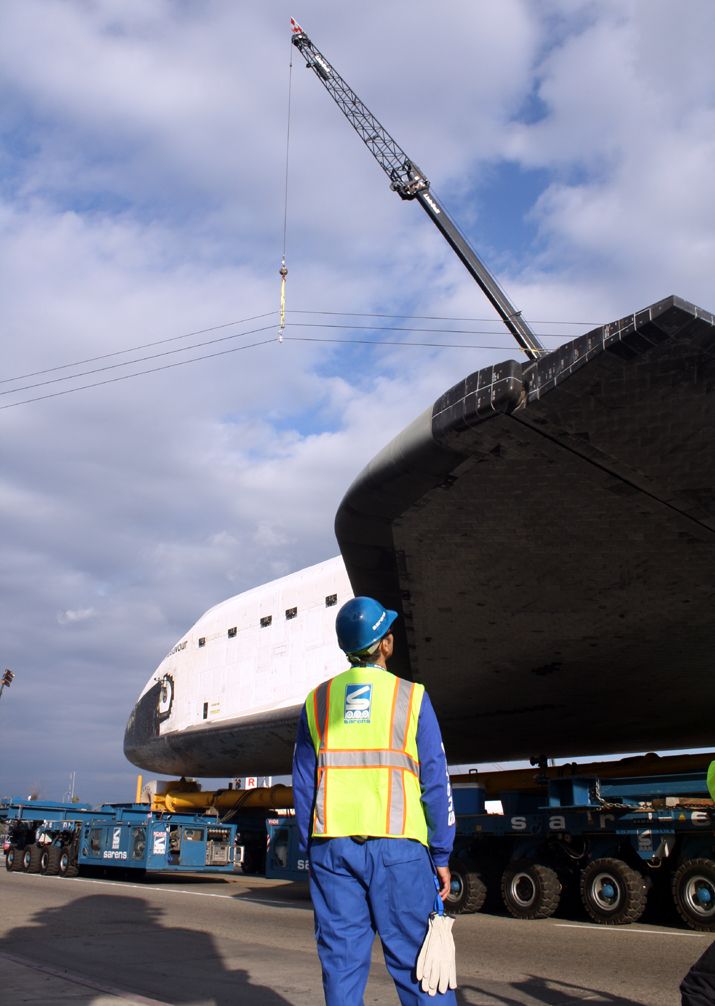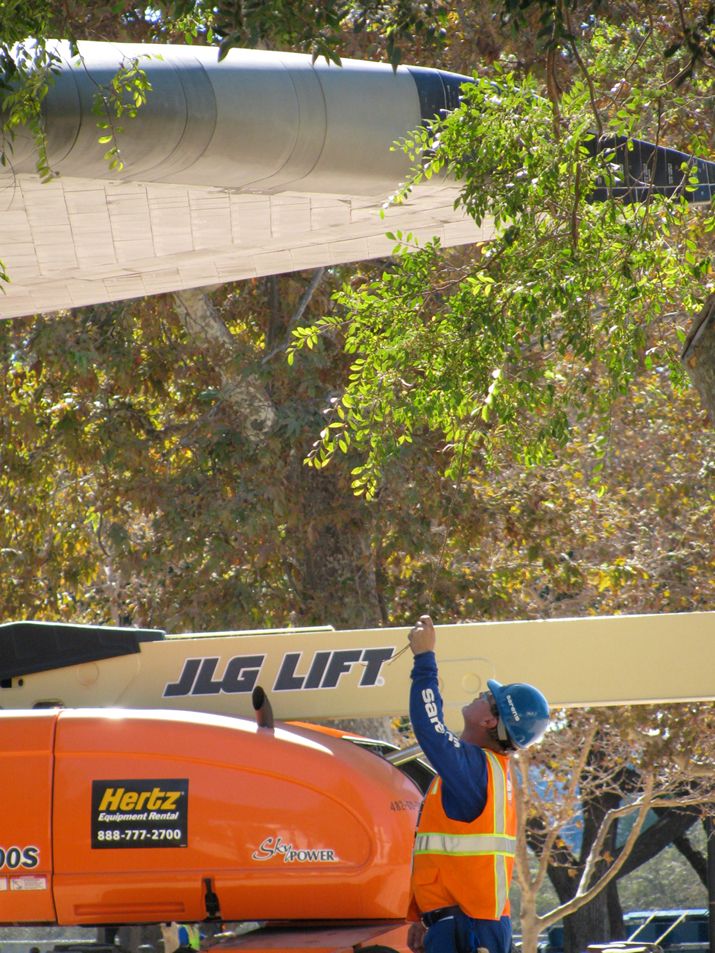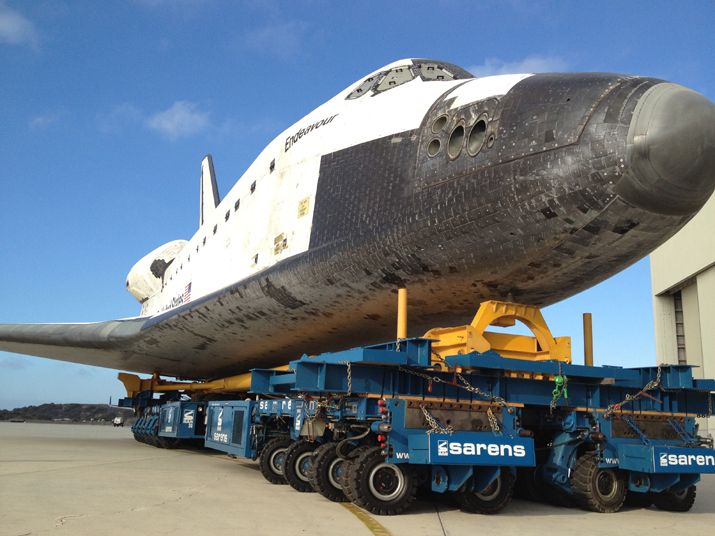Driving the Space Shuttle
How a team of experts navigated a spaceship through the streets of L.A.
/https://tf-cmsv2-smithsonianmag-media.s3.amazonaws.com/filer/shuttledriver-631.jpg)
Last October, NASA sent space shuttle Endeavour to its retirement home at the California Science Center in Los Angeles. A 747 deposited the orbiter at LAX airport, where transport experts with the Belgium-based Sarens Group picked up the reins and began the two-day, twelve-mile trek through city streets. Operator Gordon Lofts and engineer Frank Dominy of Sarens spoke to Air & Space Associate Editor Heather Goss about the surreal experience. Click on the photo gallery to see more photos, and see below for drawings and other documents from the project (or view them full-size here.)
Air & Space: Why does somebody contact Sarens?
Lofts: We move high, wide, heavy, oversized things. We have lots of cranes and lots of SPMTs – that stands for self-propelled modular trailers – to move extremely large or oversized loads. We have a large number of cranes to do heavy lifting.
What did you think when somebody told you, “I want you to move the space shuttle through Los Angeles”?
Lofts: My first impulse was that I couldn’t see it happening. I think we became a lot more excited the closer it came to reality. It was months of legwork and prep work, and as it got closer, the excitement gathered considerably.
How did the team work together to haul the shuttle?
Lofts: There were six operators, three [per] 12-hour shift. We took turns driving [by remote control] or being the guide. The driver didn’t always have the best viewpoint, so the other operators would be near the wingtips, trying to get past tight places.
Dominy: I was down in Los Angeles on several different occasions, doing measurements in the field. We had one other engineer, Joe Baddour. He was in L.A. the last three and a half months of the project. He kept double-checking things. Issues came up with trees that the city wanted to not remove so we’d check those to see if we could get around them. It was a huge engineering effort, but mostly it was just coordinating the logistics of the hauler – that was the big thing.
We had a couple other engineers we brought down just for the transport. We had a set of drawings that showed every maneuver on the whole route [see above]. I stayed ahead maybe half a block and looked at obstacles, checked what I thought we should do on the drawing, and then went back to the operator to get him to set the trailer in the right direction to clear it.
How was this different than one of your usual jobs?
Lofts: All of the operators have moved much larger, heavier objects. This was unusual because it was such a historically significant and invaluable piece, and the fact that we didn’t realize how many people would be watching. As big as the shuttle is, it’s still extremely delicate. You couldn’t touch anything with it because these black panels that were the heat shields would break and then…They have some spares and they could replace them, but it would not have been a good feeling to have damaged it.
Dominy: It was interesting because it was such a one-of-a-kind item. The shuttle only weighed about 150,000 pounds, so it was very light compared to some of the things we haul. We’ve hauled up to, I think, 2,500 tons. So the actual, physical transport was relatively simple. The equipment configuration and everything was not the challenge, the challenge was just getting around everything.
Were you nervous, knowing you had to handle this artifact?
Lofts: The closer we got… I don’t want to say nervousness or apprehension, but the importance grew because the media was blowing it up and there were all the people, and holy cow, you can either come off looking pretty good or you can come off looking pretty bad if something doesn’t work correctly or you have some problems. It did take us longer than we estimated, but we were supposed to have clearances and a lot of those clearances just were not there. They couldn’t move trees or they couldn’t move poles or any of those things that had to happen to give us clearance, so it became much more intricate of a move than it started out to be.
What was a particularly difficult obstacle that you had to choreograph movement around?
Dominy: One of the biggest challenges was getting permission to cross a bridge over the 405 interstate. California doesn’t really allow the type of equipment that we use, so we had to move the shuttle over to different equipment just to cross this one bridge. That was the area where Toyota filmed a commercial – they towed it across with their pick-up truck.
How did you deal with any obstacles you just couldn’t move?
Lofts: We had a lot of the close places mapped out ahead of time. We knew where several of them were, but the problem was that there turned out to be a lot more than we ever envisioned there were going to be. The wingspan was 78 feet, and they had told us we’d have 80 feet [of clearance] in all but maybe eight or ten places.
Wow, that’s still close.
Lofts: Oh, that wasn’t even close. There were places where we didn’t even have the 78 feet. So now you have to get creative. We would turn it a little bit diagonal and lower one wingtip and raise the other, and make its footprint a little bit smaller. Even then, there were places where you would not have wanted to have your finger between the load and the obstruction, because it was going to hurt. This is when you relied on skilled operators, telling you what clearance you had on each wingtip. The steering mechanism on this particular transporter is infinitely variable, so you would make extremely minor adjustments. When you’ve got an inch or two of clearance on something that’s 80 feet wide, you’re not talking about huge steering maneuvering, you’re talking about very delicate, very finite maneuvering. And this turned out to be hundreds of times – it was supposed to be 10 or 12 times, and it turned out to be hundreds of times.
Can you describe the haulers you were using?
Lofts: The truck – that was a publicity stunt for Toyota. Toyota gave the [California] Science Center $10 million to be able to film a commercial showing it pulling it across the freeway. That was a wide-open stretch, but it was a lot of work for us, because we had to take the regular transporting equipment out and set it up for the Toyota.
All of the real maneuvering on the road was done on KAMAGs, the SPMTs. We had four separate trailers. At times they would be closely coupled, and then there were other times when there was 21 feet between them, so we could straddle a median and other things that were in the center of the road, so the load would go over and around it. Then at other places it was too narrow to be that wide, so they would be coupled a little closer.
These [SPMTs] are an engineering marvel. They each have their own drive motor and drive wheels, and they’re computer-controlled. As long as you program the computers accurately, you just tell them what to do; each trailer knows where the other one is, so that when they move, they move as a unit. You change your programming based on the configuration of the equipment for that segment of the move.
Were the crowds distracting? Did anybody get in the way?
Dominy: The LAPD and L.A. County Sheriff had several hundred officers out to help with crowd control. There were so many people around, it was really amazing. That was actually one of the neatest things about it: all the people, all the spectators. Everybody was just really in a good mood. There were no problems, and it was just a great feeling to see all the people who were so happy to see this thing come through their neighborhoods.
Lofts: The police did pretty good the first night, but after that, the crowds were just so large, there wasn’t anywhere near enough police to keep them away. When you have a wingtip that’s hanging over a sidewalk where all these people are, and you’re trying to watch the clearance on a tree, they’d be standing there flashing a camera in your eyes. So…they weren’t always a help, let’s put it that way. But then you would clear it and the crowd would roar. There were huge cheering sections. There were some long, trying days and they’d give you a lot of stimulus with their appreciation. And you’re talking about Martin Luther King [Boulevard] in downtown Los Angeles; it’s not upscale by any means. Sometimes someone would stand out and get their picture taken and you’d hear them say, “Man, this is the most exciting thing that’s ever happened in my life.” Even the police captain said, “We ought to do this again next week. The crime – we haven’t had any, they’re all here watching this.”
Who knew that all you had to do was pull a space shuttle through the city! Was there anyone who complained?
Lofts: No one that we witnessed. Some of the businesses took advantage of it. It was good for business because there were lots of people, so any McDonalds or something like that was just swamped with people, obviously. But we were pretty much in our own little capsule, too. I’m sure there were some businesses that may have been inconvenienced, due to the road being shut down and blocking traffic into their establishment, but nothing that we were ever aware of.
Did you ever get to take a step back and let it sink in how cool this was?
Lofts: When the 747 that brought it from Florida did a fly-by at the airport, it was just tremendous. They landed and taxied out to where we were standing, and this guy steps out with an enormous American flag and it was just…it couldn’t help but put your heart in your throat. It was a very rewarding moment. After that the work began, and during the move there were not many occasions when you could sit back and relax – it was a lot of work.
Anything else you want to add?
Lofts: This was definitely not a one-man show; it was a huge group effort. The operators were probably the most high-profile, though at any given point I don’t think anyone had a clue who was really operating it. Often the operator was 60 or 70 feet out in front of it, and the guys really controlling it were on the wingtips telling the operator what to do. And other people were watching for wires or proximity to trees or branches or buildings. Then there were the crews who moved all the wires ahead of time and took down all the street lighting and had to go put it back, the unnamed people that played a large part but that people don’t really give any consideration to.
The Sarens team was led by project manager Ken Carrion, with operators Gordon Lofts, Mike Lofts, Steve Mitchell, John Palmer, Louie Bello and Tel Reynolds, and engineers Frank Dominy and Joe Baddour.
<script src="//s3.amazonaws.com/s3.documentcloud.org/viewer/loader.js"></script> <script> DV.load("//www.documentcloud.org/documents/700630-shuttlemovedrawings.js", { width: 631, height: 900, sidebar: false, text: false, container: "#DV-viewer-700630-shuttlemovedrawings" }); </script> <noscript> ShuttleMoveDrawings (PDF)
ShuttleMoveDrawings (Text) </noscript>
